Devecchi Gabriele
Designer, architect, goldsmith, artist and lecturer, he lived and worked in Milan where he was born in 1938. The sign that unifies the articulation of the various operating areas is of the opinion that things are ambiguous and unstable in space and time. Not forms but processes open to external intervention, to favor unpredictable metamorphic continuum. These are the immersive and interactive environments of the T group. Also in the silver-applied design - for its Milanese laboratory - and in projects for gold, porcelain or glass artifacts, he tends to product objects that are ironic manufacturers of changing messages and dialogic relations with those who use them. The theme of the viewer's participation is always present in the writings in which he speculates that the true contemporary craftsman is the ultimate consumer, induced to build artifacts from the standardized offer of semi-finished and optional to assemble. The experimental tension is confirmed in the various years of didactic activity for design, organized by preceding the concrete and perceptual manipulation of materials to modeling and theoretical information.
Meet Davide Boriani on admission exam at Brera Art High School.
His father, sculptor and engraver, in 1962 led him to the conduction of the family silverware workshop after 5 years of apprenticeship and artistic experience.
Influenced by Fontana, informal and monochromes, in October 1959 he founded together with his friends Boriani, Colombo and Anceschi, the Group T.
After meeting with Bruno Munari, he decides to embark on a completely experimental road.
In the early 1970s, he actively participated in the struggles against the expulsion of the popular inhabitants of the Quartiere Garibaldi in Milan, from which the Politecnico's thesis was born, on the theme of the socio-architectural recovery of the Milan Neo-conservator.
In the same years he taught at the Brera Academy.
In the 1980s he was national president of the World Crafts Council and in the 1990s he was the national vice-president of CNA - Artistic in which he worked to eliminate the distinctions between the major, the lesser and applied in the artistic work.
He designed multisensor silver, innovative porcelain for Ginori, furniture and objects and received a special report at the Compasso d'Oro in 2001.
In the same years he continued teaching at the European Design Institute in Milan, at Politecnico, at Bicocca University and at the Accademia di Brera.
Since 2007 he also teaches at Cladis-IUAV Foundations of two-dimensional design.
He dies in Milan in 2011.
1956/58.
He accompanies to the metal realizations, the abstract / informal polymateric experiments that he exhibits with Carlo Berta, Davide Boriani and Gianni Colombo at the Bellinzona Government Palace and the Sala del Lyceum Of Lugano with a presentation by young critic Gualtiero Shoneberger. They are the first encouraging sales.
1959.
He won the "Formica Domus" award for designs to be interlaced.
1959 is the year of great debates on the crisis of art and its socio-cultural function. They are also the years
where the future members of GroupT relate to the latest hypotheses of international avant-garde, from the German acroms to the works of Ives Klein to that of the Japanese Gutai group and to the Lucio Fontana's space proposals. After the monochrome reliefs exhibited at the Galleria Pater, Milan (with
Anceschi, Boriani and Colombo) and a collective at the Azimuth gallery, a gallery to which he collaborates
with Manzoni and Castellani and the members of the future GroupT, realizes with the establishment of the GroupT Concrete and poetic detachment from both the informal and Manzoni and Castellani.
1960
MIRIORAMA is the term that defines the exhibition activity of GroupT alone. The need to give a name to the exhibits was a distance from the usual in the chain of the traditional art system, hence not personal to the group but to miriorama.
Miriorama 1, the first of six consecutive. GroupT exhibit debut with collective works "smoke framework", "combustion plastics", "thermal oxidation copper" and "Large pneumatic object - variable volume environment". Miriorama 3, featuring the first "vibrating surfaces", the "modular theater" and two "sculptures to kick." With the decision to include 4 personal, one-to-one, in the opening of Group T the significance of Miriorama was extended also as a moment of integration of the respective achievements in the collective. Lucio Fontana involves the Group in the proposals for the decoration of the Torre del Parco Sempione at the Triennale of Milan.
Miriorama 8, a "miramondo" presentation of one of the 5 multiples, numbered and signed from 1 to 10, one for each component of Group T. Multiple does not mean iteration of a prototype but a project whose product is 10 objects of Equivalent content and aesthetic function and open to user customization. Art designed, realized and diffused through the design methodologies. Show room Danese, Milan.
1961
Manifesto for the international racing competition on the occasion of "Italia 61", Turin.
Group T participate with multiples at the "Bewogen-Beweging" exhibition, Stedelijk Museum in Amsterdam.
Presented by Bruno Munari and the critic Suzo Takiguchi accomplish, with 3 works each specially made in size and weight for air shipping in Japan, Miriorama 9 at Minami Gallery in Tokyo. New "Compographic" work consisting of three transparent squares, appropriately engraved, which overlapping determine various images.
With the presentation of Lucio Fontana is Miriorama 10 at La salita Gallery of Rome with the most consolidated works of the Group T, here meet among others Toti Scialoja, Cy Twomblj, George Rikey, and the peers Festa and Schifano.
The Group participates in the 9th Spoleto Prize, an event organized at the Musical Festival, where the
"Vibration surface" gets the prize.
For the 1962 Bomberian Literary Almanac, dedicated to the world of computers, by Umberto Eco and Bruno Munari, he made two programmed graphics.
1962
The work of Group T intensifies with active participation in the programmed art. The inaugural exhibition, curated by Bruno Munari and presented by Umberto Eco, presents the work of Munari, Enzo Mari, T and N Groups at the Olivetti show room in Milan.
After Milan, Rome, Venice, Genoa, Tokyo and Düsseldorf, Olivetti show room in Rome, in gallery in Trieste, Berlin and London, then overseas with the increase of works and the involvement of the GRAV, exhibitions at Universities and museums USA, concluding at New York's MoMa.
GroupT's exhibition at Naviglio's gallery in Milan where he presents the object with air lines.
Miriorama 11, Enne's studio, in Padua with the presentation of Bruno Munari, Miriorama 12, Galleria del Cavallino, Venice with permutable poetry by Nanni Balestrini.
Milan "Parata Luci", the chromatic decoration of the Tower of Piazza Duomo, designed by V. Viganò in collaboration with Livio Castiglioni and Bruno Munari.
The GroupT will realize the fountain of the Cavallino library as part of the XXXI Venice Biennale.
1963
He takes part in "Oltre l’informale", "Fourth International Biennial of San Marino" and at the international exhibition "Nove Tendencjie 2" Suvremene Umjetnosti gallery, Zagreb and Fondazione Querini Stampalia, Venice.
Exhibits a collection of silver jewelery of varying shape in the Milan showroom in Milan.
At the Cadario gallery in Milan and at the Compass of Turin in the collective exhibition "Oltre la pittura, oltre la scultura" he exhibits the triangular structure and Rotolineare.
Miriorama 13, Christmas 1963, Galleria del Naviglio, Milan.
1964
The Nouvelle Tendance show at the Pavillon de Marsan, the Musée des Arts Décoratifs in Paris, marks after the first collective atmosphere of Miriorama 1, the shift from designing objects to the almost exclusive design and implementation of environments by the members of the Group T. The artist participates in the Parisian NT with a triangular structure. He participates in the XIII Triennale of Milan with a silver box.
Group T Room at XXXII Venice Biennale.
Design of the kinetic object for the manipulation of light-shadow ratio Assonometric deformation.
Miriorama 14, Studio F, Ulm corresponds to a change in T Group's activity, meaning that the extension of exhibition possibilities and the transition to environments did not facilitate the organization of group exhibitions, so XIV ° was The last Miriorama.
1965
"Nove tendencjie3", Zagreb.
Exhibitions: Nul 65, Stedelijk Museum, Amsterdam; Licht und Bewegung, Kunsthalle, Berne; Perpetuum Mobile, Obelisco Gallery, Rome; Cinetics Palazzo Costanzi, Trieste.
For Edition Mat he realizes the multiple in 35 specimens Assonometric Deformation 35, Galerie Der Spiegel, Cologne.
1966
KunstLichtKunst is the international exhibition at van Abbemuseum in Eindhoven where the Group is involved with 3 individual environments and works; G. Devecchi creates a shadowed environment - Virtual Parameters.
Sigma II, Art Visuelle, Galerie de Beaux Arts, Boredeaux.
Structures by Gabriele Devecchi, solo show in Milan, Vismara gallery, with presentation by Gillo Dorfles. Exhibitions: Edition Mat Gallery Actuel, Bern; Comparative Trends Gallery of the Center, Naples;
Art of the space Johannesburg.
1967
With the kinetic object "Structure Q2" he wins fairly with De Alexandris the Painting National Award for Silvestro Lega, C. Castelli Foundation, Modigliana.
“The space of the image” for the first time in Italy shows a collective of only environments, collaboration with Gianni Colombo for programmed living situation and personal space for virtual structuring, a variant of the environment of Eindhoven.
Paolo Scheggi invites in his studio the GroupT and the Romans Festa, Schifano, Angeli and others to agree a common action of contestation of the XXXIV Venice Biennale.
1968
At the Maison de la Cultura in Grenoble in Cinetisme-spectacle-environnement, the programmed obstacle path, realized on half of the rotating stage of the theater with GT, Mari and Massironi, the rest of the stage is made by the French of GRAV.
Marriage with Corinna Morandi who will be present in some art and design demonstrations and projects.
Invitation to the XIV Triennial initiative of Milan, 30 artists in the Italian landscape for which he designs for the subway of Viale Scarampo a set of fluorescent white road trails, provided by the 3M sponsor, on the floor, walls and ceiling with the aim of destabilizing trajectories of vehicles. For the Triennial contest the project did not see the realization.
Tour “One Hundred Italian Artworks from Futurism to Today” at the National Gallery of Modern Art in Rome at: Rome, Bochum, Berlin, Cologne, Warsaw, Malmö, Stockholm.
1969
Solo show at the Milan Diagram Gallery with the environment at light lines - Bright Parameters.
Participation in Nine Tencencjie 4 with the NT4-zag environment in which the light lines were produced by a removable device. For the Campo Urbano exhibition in Como, he made an artificial storm with Edilio Alpini, Davide Boriani and Gianni Colombo.
Designs the inaugural "Filter Area" for the Cassina showroom in Milan, conceived as separation and connection between road and exhibition, by the designer of the entire Mario Bellini space.
Participation in: “Oltre la pittura”, VII biennial of contemporary art; Visuelt Milijø, Kunsternes Hus, Oslo.
1971/72
The exhibit activity is very slow, I quote Milan 70/70 an important exhibition on a century of Milan activity in the avant-garde of architecture and plastic and figurative arts.
Silver Collection "New Form", designed with C. Morandi. Conversely, the life of the study is very lively for meetings with colleagues and students.
Show "Copia dal vero" to the Cenobio / Visualità gallery with a variation of the ambient lighting design with light parameters with lights coming from the road vehicle lights filtered from the semi-open grilles of a window.
1973
Called at the Accademia di Brera, he teaches in Techniques and Materials and through group teaching he brings students to the design of a multipurpose mobile for nursery school.
With Boriani, Colombo, LeParc, Morellet, Stein painting meeting "Italy France Peinture en plain air" at the Cenobio / Visualità gallery on a project elaborated with Boriani the previous year.
Intervention in the territory "Volterra 73" by Enrico Crispolti. With Boriani and Forges Davanzati with a double intervention, on the one hand, plans for alabaster and, on the other hand, plaster casts of body parts distributed for the walls of the historic center of the city.
He participates in the X Quadriennale of Rome.
Project "Steps" collection of objects of use by subdivision and reconfiguration of a single silver matrix.
"What is art?" TV installation in collaboration with Boriani and VDN studio for the XXVIII Biennial of Milan.
1974
Since 1973 an initiative was taken by the citizens of Sesto San Giovanni, animated by members of the Torretta club and the critics Aurelio Natali and Maurizio Vitta and the artists Devecchi, Boriani and Barbanti. The occasion to intervene was the challenge of the XIV Painting Prize Piazzetta revitalized through the QT1 project, responding to the demand for the citizens to design a playground for the area they identified, with Devecchi, Boriani, Barbanti and discussed with the inhabitants, it was shaped to the project and built a model.
With Boriani he created "Cronostatic Environment" for the Civic Collections of Art of Cagliari.
Design and plastics with Boriani and Munari for the Montedison Center in Via Cavallotti in Milan.
1976
Art as Social, XXXVIII Biennale of Venice where he replaces its participation with the exhibition of the Quarterly Committees of the Historical Center of Milan, photographs, banners and posters of 25 years of struggle.
1977
Italian Art 60/77, Contemporary Art Gallery, Turin.
1978
Postcard for MAIL ART postcard, organized and curated by Luisa and Ico Parisi Vase "Phoemina" of the collection of objects / mirror "Minimal that experiences the deformation of shape and image reflected in a forced surface in irregular profiles"; by Enrico Crispolti "Extra media book" composed of a sixteenth typographic in free speech for each invited artist. With Francesco Pagliari realization with images of hypotheses of integration between territory, city, school and Cultural Heritage. At the Cabaret Voltaire, Turin, on-screen cinematic projection of simultaneous and integrated images of artistic goods and daily gestures.
1979
Participation in "Design and Design" exhibition, entrusted to E. Mari. At the Galleria Blu di Milano, show of design/design projects for the Design and Design.
Invitation to the exhibition "L'ombra", Casa del Mantegna, Mantua with the work "Assonometric Deformation" and "The Roots of Contemporary Art - From the Scientific Ratio" by Marco Meneguzzo and Anty Pansera, Civic Library of Monza.
1981
Collaboration for the design and installation of the exhibition "Where is the artisan", by E. Mari, Fortezza da Basso, Florence and Palazzo della Triennale, Milan.
The Candeliere 600, inaugurates the design of the silver collection "History".
1982
Italian art 60/82, Hayward Gallery, London by Aldo Ballo.
1983
Exhibition of programmed and cinematic art 1953/1963, the latest avant-garde, Royal Palace, Milan, edited by Lea Vergine. The cut of the exhibition recovers all the participants in the NT movement, thus including kinetic and programmed movements more closely related to inogative and optical art. The dating was also unhappy in the sense that the maturity of the programmatic art was expressed from 1960 to 1968 mainly through groups T and G.R.A.V. with environments.
Participation in Electrà, Musée d'Art Moderne de la Ville de Paris.
1986
Participation in the "Art and Science" section of the XXXXII Venice Biennale, curated by Attilio Marcolli
1989
Personal Show "Cronorama", ArteStruktura gallery, Milan
Invitation to participate in "nine projects for Richard Ginori", curated by Luigi Massoni
1992
As part of IED's teaching activity, he organizes "St'Art", a yearly design of silver designed by students to complete the training and to point the sector to the opportunity to address young designers to innovate the obsolete offer.
Participation in exhibitions: "The Artistic Craft Image", Market Theathre, Johannesburg; "X Silbertriennale", Hanau; The Italian Art of Living, and "Handicraft Conference", New York; "Ornamenta", edited by Tersilla Giacobone, Silver of MAC at Castello Sforzesco, Milan; Souvenir, Catholic (FO).
1993
"The gestaltic avant-garde of the 60s", Munari, Mari, Groups T and N with extension to Piero Manzoni and Enrico Castellani, showroom Baleri Italia, Milan.
1995
"Two centuries of sculpture", a show dedicated to the teachers of the AABB of Brera, Palazzo della Permanente, Milan.
Design of crystal furniture for Gallotti & Radice, Como. Design of a travertine bench for the exhibition A heart for a friend, Palazzo della Triennale, Milan, production of Vaselli, Rapolano. Creation of an angelic trumpet of 4 meters for the exhibition In the sign of the angel, gallery Bianca Pilat, Milan. URMNT loan for Zero Italia exhibition, Galerien der Stadt Esslingen, Villa Merkel.
1996
Exhibition of cinematic works, with materials restored and redeemed by a long oblivion, National Gallery of Modern Art, Rome.
Participation at: "XII Silbertriennale", Munich, Prague; "Made in art" gallery of Third Millennium, Milan; "Eenhuis vol silver", Antiek J.M.A. Nachtergaele, Gent, Belgium; "Distractions", gallery Materia Prima arts & crafts, Venice.
"Lumiere et mouvement", Galerie Denise Rene, Paris.
"The Sixties", Fondazione Mazzotta, Milan.
1997
"The Speech Language - The Devecchi Atelier, 50 Years of Silver Story", by Giovanni Anceschi with catalog by Tersilla Giacobone, Triennale di Milano.
"Show 100x100", ArteStruktura gallery, Milan.
2000
First Prize A.M.I. Zurich 2000 for silver.
2001
Marco Meneguzzo "Programmed and Kinetic Arts in Italy 1958-1968" Art Gallery Niccoli, Parma.
Enrico Crispolti "Gold Imagination. Artist-Goldsmiths and Jewelers-Artists in Italy in the Twentieth Century ", Mole Antonelliana, Ancona.
M. Meneguzzo and V. Feierabend "1958/1968 Light, Movement & Programming. Kinetische Kunst aus Italien ", the Ulmer Musem, the Staedtische Kunsthalle Mannheim, the Staedtische Museum Gelsenkirchen, the Stadtgelerie Kiel, the Staatliches Museum Schwerin, the Alpen-Adria-Galerie, Klagenfurt.
2002
Receives an honorary announcement for “Ring”, kinesthetic rings at the Triumphal Exhibition of the Golden Compass of the Triennale, Milan.
Participation in the Contemporary and Modern Art Exhibition 1902/2002, Turin.
Realizes the environmental installation "Miramondo" in the exhibition "The glasses" Palazzo della Triennale, Milan.
2003
Show Einbildung-Das Wahrnehemen in der Kunst ". Kunsthaus Graz-Argenti at the 1950/2000-Theater of Italian Creativity "at 545 West 22nd Street, New York
2004
"The T Show Room B & B Italy" in New York
"Die Algorithmische Revolution Zentrum Kunst Medientechnologie", Karlsruhe
2005
Praguebiennale2- expanded painting / accion directa Prague
"The T-Group Environments The Origins of Interactive Art" National Gallery of Modern Art, Rome 2005/2006
2006
"Faster! Bigger !, Better! "Zentrum fur Kunst Medientechnologie, Karlsruhe," Die Neuen Tendenzen- eine europaische Kunstlerbewegung "Museum für Koncrete Art, Ingolstad
2007
"Cinetica" CID Museum, Torviscosa, Udine
"Die Neuen Tendenzen- eine europaische Kunstlerbewegung", Museum für Koncrete Art, Duren
"OP ART", Schirn Kunsthalle, Frankfurt,
"Bit International- [Nove Tendencije- Computer and Visual Research]", Neue Galerie, Graz.
"Cinetica" CID Museum, Torviscosa, Udine


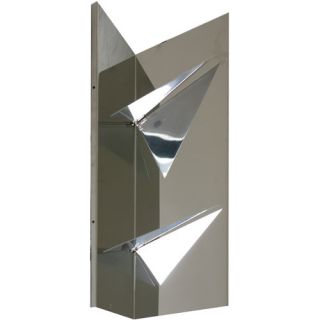
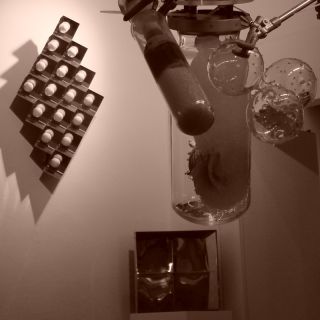 L'invadenza della tecnologia, l'impossibilità di evitarla - Getulio Alviani?, Joel Stein vs Enrico T. De Paris
L'invadenza della tecnologia, l'impossibilità di evitarla - Getulio Alviani?, Joel Stein vs Enrico T. De Paris ITALIAN ZERO/CROSS REFERENCE
ITALIAN ZERO/CROSS REFERENCE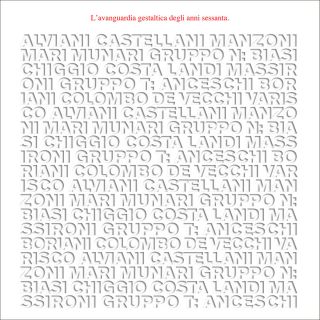 L'AVANGUARDIA GESTALTICA DEGLI ANNI SESSANTA _ CINQUANT’ANNI DOPO
L'AVANGUARDIA GESTALTICA DEGLI ANNI SESSANTA _ CINQUANT’ANNI DOPO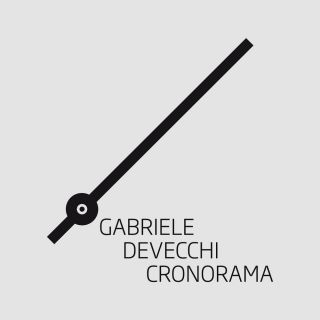 GABRIELE DEVECCHI_CRONORAMA
GABRIELE DEVECCHI_CRONORAMA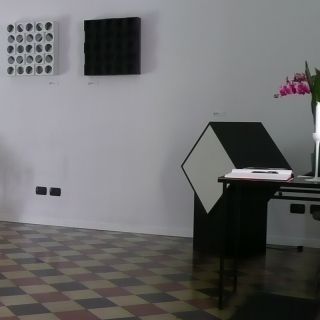 Leggere dagli anni sessanta: Milano
Leggere dagli anni sessanta: Milano Licht und bewegung
Licht und bewegung